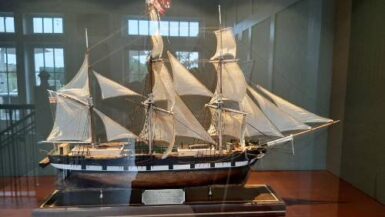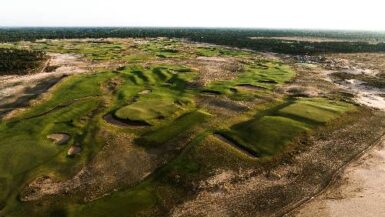“Take your bottom lip, and pull it up over your head.”
That was how comedian Bill Cosby once said that Carol Burnett described labor pains, but it also depicts how it feels to flush a 4-up lead in golf to the drummer of a punk rock/ top-40 band, but I’m getting ahead of myself.
The stars were still bright when Gary Wiseman’s Escalade pulled into the Quik-E-Mart so we could get cappuccino. Still shaking out the cobwebs of a waking hour that would have been indecent to an archangel and was downright criminal to mortals, we sped away from Denton towards Austin as the first grey streaks broke the eastern horizon. They illuminated mile after mile of barren flatlands northwest of the Texas Hill Country, and we couldn’t help be awestruck by the boundlessness, profound solitude of the landscape and the raw, prismatic ruby light of dawn.
Yet as we wheeled our way southeast, the light grew inexorably brighter and the terrain more varied and compelling. The Hill Country is rightfully famous for its splendor. The garden of Texas, it flowers brightly and proudly, even in winter’s chill. There is nothing in Texas to match it. Even Texans marvel at it, which is remarkable. It’s hard to impress Texans.
Many of Texas’s most celebrated courses are in the region, but it was only fitting that Pete Dye, the greatest American golf architect for more than a generation, would create a masterpiece at Austin Country Club that would take advantage of some of the most arresting and diverse terrain found anywhere in the state. Now in its third incarnation, Austin Country Club is regarded by some as arguably the best private course in Texas. First built in 1899 and occupying land on 41st Street, the course moved to Riverside Drive until 1984, when the members bought a 180-acre plot bordering the Lake Austin, at the north side of town, and set Dye to his cunning devices.
The mid-80s were the apex of the target golf craze, and Dye was riding the crest of a high and unstoppable wave after the runaway success of Sawgrass. But with every client wanting a harder course – because television made it seem that harder was better – it a minor miracle that Austin C.C. is as great a design as it is. The terrain is severe, with canyons, a lake, and woodlands. Anyone could have laid out a devastatingly penal golf course. But back then, only Dye could weave brilliant, yet subtle strategies like alternating shot requirements over a course that had every natural hazard conceivable.
As Dye learned in the U.K., the best holes play into the teeth of the natural features. Dye skillfully used the diagonal angles of the canyon for some holes, recreated some excellent holes from Sawgrass for others, and used the elevation changes as defenses for the remainder.
The course isn’t subtle. It doesn’t tantalizingly tempt you. You see the challenges ahead and they are well defined and penal. One pundit opined that the property was so severe, only a severe design could result. He also called the lake holes “forgettable.”
That’s completely wrong. The lakeside holes are the best; they are both stunning and subtly strategic, with cunning alternate shots requirements. Most agree that the short but dangerous par-5 third hole is reminiscent of sixteen at Sawgrass. The short par-4 fourth is a Cape hole, which Dye has used to great effect at several courses like Sawgrass and PGA Golf Club in Port St. Lucie, Florida. Six and seven play like fourteen and fifteen at Sawgrass: back to back holes with alternate shot requirements, the par-4 sixth is fade off the tee, draw into the green, the par-5 fifth is draw off the tee, fade into the green.
All of the par-3s have forced carries and treacherous hazards, especially the second, (all carry over water), and the eighth, (all carry over a gaping chasm). Only the sixteenth plays downhill, which is guarded by a waste bunker.
The course changes complexion completely on the back nine, as Deer Creek Canyon winds its sinuous way across eleven, twelve, and thirteen. These holes are not for the feint of heart or rickety of swing. At eleven, dubbed “Earth’s Edge,” it’s a forced carry over the canyon on the drive, then a hair raising approach as the world literally falls away all along the left all the way to the green. The right, of course, is protected by a pot bunker, so bailing out is unwise. If you land in the bunker, the recovery shot is played – you guessed it – right towards the canyon you were trying to avoid in the first place.
By the way, guess which way the green rolls. Right first time! Toward the canyon.
Even though the course’s penal aspects make it so you’re on high alert all day, the wild ride, a golf version of a bucking bronco is refreshing compared to the majority of Texas’s courses. Every hole shows you something different.
Eighteen is a summation of all that came before. A brutishly long par-4, (480 tips 460 next box down), the drive is threaded between unplayable jungle on the left and a chasm with a pot bunker on the right. The approach calls for a draw withj one last chance to drop a Pro-V1 in the canyon on the left to end the day…
…which is exactly what I did to lose my match to Gary.
Now I just got done telling you the course is a pitiless enemy, and no tears or screams will move its hard heart, and that when players break they break hard and jagged. What does your idiot author go and do? 4-up after six holes and on the verge of going 5-up after seven, he thinks to himself. “Once I win this hole, I can cruise home.”
That did it. That was the starter’s pistol for all the Furies of the Sports Gods to come riding into Austin on their Steeds of Vengeance.
Sweet Lord in Heaven, did I choke the rest of the way. Sherman, the French Bulldog who is the mascot of Gary’s band, Bowling For Soup, could have played better then I did. On the back nine, my swing looked like “Shaq-Fu trying to break the backboard” instead of my normal “man swatting hornets in a phone booth.” Every time Gary opened the door for me, I promptly banged my head on the jamb. I found all the trouble and at the worst possible time. Oh well, Gary, our playing partner, the affable oilman Wyatt Halliday, (a two handicap), and I had a great day nonetheless, enjoying the club legendary instructor Harvey Pennick and two time Masters Chapion Ben Crenshaw called home. In Harvey’s case, he was at A.C.C. for eighty-two years, from a caddie as a kid to head pro emeritus in his winter years.
So for one more glorious day, Gary, Wyatt, and I shared The Sportlight: that warm feeling of camaraderie during athletic endeavors that unites players in shared glorious experiences, and transcends the ethos of all other endeavors known to man. As the course faded in the gloaming and we sped our way back to Denton and dinner at Sweetwater Restaurant, (which has the best jalapeno poppers and rib-eye specials in the country, and is packed with savvy golf fans), we all knew we had played one of the most unsung courses in the country.
———————————————————————————————-
Pete Dye is an icon. He’s the lunar cycle that moves the wave of golf course architecture which has swept the craft away from penal architecture and toward more strategic elements such as alternate shot patterns and diagonal hazards. Brilliant minds such as Tom Doak, Mike Strantz, and Brian Silva all wither studied under Dye, or claimed that his ideology significantly affected their design concepts. Only Pete could take such a penal site, and craft a course with so many strategic elements as well, even though often times you wanted to hide your eyes by taking your bottom lip and pulling it up over your head.
Design: Six stars
Natural Setting: Five and ½ – Six stars
Conditioning: Six stars
Overall: Five and ½ – Six stars




